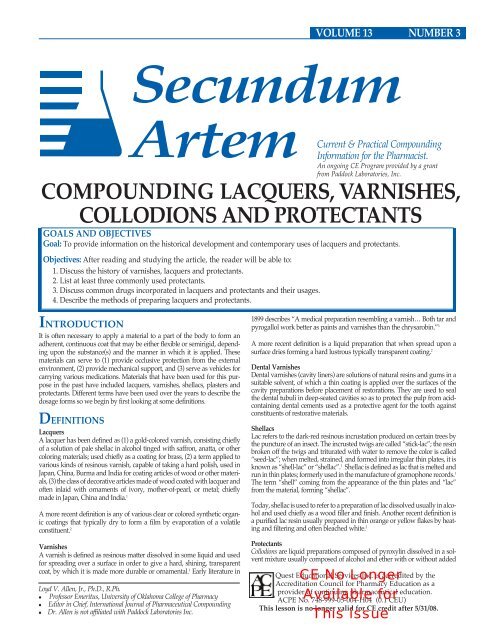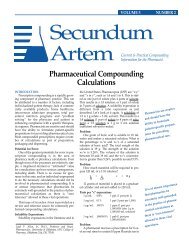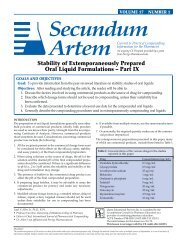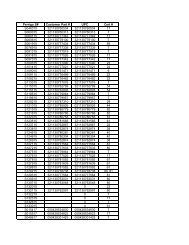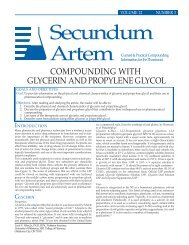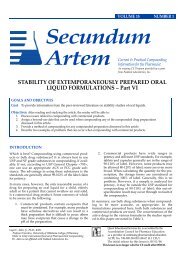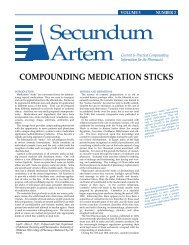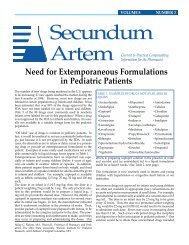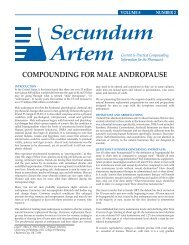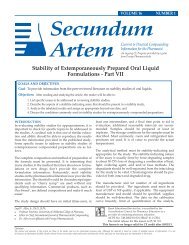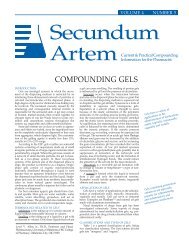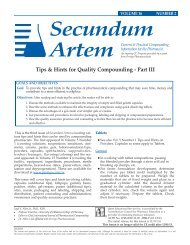Sec Artem 13.3.pdf - Perrigo Company
Sec Artem 13.3.pdf - Perrigo Company
Sec Artem 13.3.pdf - Perrigo Company
You also want an ePaper? Increase the reach of your titles
YUMPU automatically turns print PDFs into web optimized ePapers that Google loves.
VOLUME 13 NUMBER 3<br />
<strong>Sec</strong>undum<br />
<strong>Artem</strong><br />
INTRODUCTION<br />
It is often necessary to apply a material to a part of the body to form an<br />
adherent, continuous coat that may be either flexible or semirigid, depending<br />
upon the substance(s) and the manner in which it is applied. These<br />
materials can serve to (1) provide occlusive protection from the external<br />
environment, (2) provide mechanical support, and (3) serve as vehicles for<br />
carrying various medications. Materials that have been used for this purpose<br />
in the past have included lacquers, varnishes, shellacs, plasters and<br />
protectants. Different terms have been used over the years to describe the<br />
dosage forms so we begin by first looking at some definitions.<br />
DEFINITIONS<br />
Lacquers<br />
A lacquer has been defined as (1) a gold-colored varnish, consisting chiefly<br />
of a solution of pale shellac in alcohol tinged with saffron, anatta, or other<br />
coloring materials; used chiefly as a coating for brass, (2) a term applied to<br />
various kinds of resinous varnish, capable of taking a hard polish, used in<br />
Japan, China, Burma and India for coating articles of wood or other materials,<br />
(3) the class of decorative articles made of wood coated with lacquer and<br />
often inlaid with ornaments of ivory, mother-of-pearl, or metal; chiefly<br />
made in Japan, China and India. 1<br />
A more recent definition is any of various clear or colored synthetic organic<br />
coatings that typically dry to form a film by evaporation of a volatile<br />
constituent. 2<br />
Varnishes<br />
A varnish is defined as resinous matter dissolved in some liquid and used<br />
for spreading over a surface in order to give a hard, shining, transparent<br />
coat, by which it is made more durable or ornamental. 1 Early literature in<br />
Current & Practical Compounding<br />
Information for the Pharmacist.<br />
An ongoing CE Program provided by a grant<br />
from Paddock Laboratories, Inc.<br />
COMPOUNDING LACQUERS, VARNISHES,<br />
COLLODIONS AND PROTECTANTS<br />
GOALS AND OBJECTIVES<br />
Goal: To provide information on the historical development and contemporary uses of lacquers and protectants.<br />
Objectives: After reading and studying the article, the reader will be able to:<br />
1. Discuss the history of varnishes, lacquers and protectants.<br />
2. List at least three commonly used protectants.<br />
3. Discuss common drugs incorporated in lacquers and protectants and their usages.<br />
4. Describe the methods of preparing lacquers and protectants.<br />
Loyd V. Allen, Jr., Ph.D., R.Ph.<br />
Professor Emeritus, University of Oklahoma College of Pharmacy<br />
Editor in Chief, International Journal of Pharmaceutical Compounding<br />
Dr. Allen is not affiliated with Paddock Laboratories Inc.<br />
1899 describes “A medical preparation resembling a varnish… Both tar and<br />
pyrogallol work better as paints and varnishes than the chrysarobin.” 3<br />
A more recent definition is a liquid preparation that when spread upon a<br />
surface dries forming a hard lustrous typically transparent coating. 2<br />
Dental Varnishes<br />
Dental varnishes (cavity liners) are solutions of natural resins and gums in a<br />
suitable solvent, of which a thin coating is applied over the surfaces of the<br />
cavity preparations before placement of restorations. They are used to seal<br />
the dental tubuli in deep-seated cavities so as to protect the pulp from acidcontaining<br />
dental cements used as a protective agent for the tooth against<br />
constituents of restorative materials.<br />
Shellacs<br />
Lac refers to the dark-red resinous incrustation produced on certain trees by<br />
the puncture of an insect. The incrusted twigs are called “stick-lac”; the resin<br />
broken off the twigs and triturated with water to remove the color is called<br />
“seed-lac”; when melted, strained, and formed into irregular thin plates, it is<br />
known as “shell-lac” or “shellac”. 1 Shellac is defined as lac that is melted and<br />
run in thin plates; formerly used in the manufacture of gramophone records. 1<br />
The term “shell” coming from the appearance of the thin plates and “lac”<br />
from the material, forming “shellac”.<br />
Today, shellac is used to refer to a preparation of lac dissolved usually in alcohol<br />
and used chiefly as a wood filler and finish. Another recent definition is<br />
a purified lac resin usually prepared in thin orange or yellow flakes by heating<br />
and filtering and often bleached white. 2<br />
Protectants<br />
Collodions are liquid preparations composed of pyroxylin dissolved in a solvent<br />
mixture usually composed of alcohol and ether with or without added<br />
Quest Educational Services Inc. is accredited by the<br />
Accreditation Council for Pharmacy Education as a<br />
provider of continuing pharmaceutical education.<br />
ACPE No. 748-999-05-004-H04 (0.1 CEU)<br />
This lesson is no longer valid for CE credit after 5/31/08.
medicinal substances. They are often applied to cuts and small burns as a protective.<br />
Application often causes pain but it is effective as an antiseptic and for<br />
excluding air from open wounds.<br />
Pyroxylin (soluble gun cotton, collodion cotton) is obtained by the action of a<br />
mixture of nitric and sulfuric acids on cotton and consists chiefly of cellulose<br />
tetranitrate. It has the appearance of raw cotton when dry but is harsh to the<br />
touch. It is frequently available commercially moistened with about 30% alcohol<br />
or other similar solvent.<br />
One part of pyroxylin is slowly but completely soluble in 25 parts of a mixture<br />
of 3 volumes of ether and 1 volume of alcohol. It is also soluble in acetone<br />
and glacial acetic acid. Pyroxylin is precipitated from solution in these solvents<br />
upon the addition of water. Note: Pyroxylin, like collodion, is exceedingly<br />
flammable and must be stored away from flame in well-closed containers, protected<br />
from light.<br />
Collodions are intended for external use. When applied to the skin with a fine<br />
camel's hair brush or glass applicator, the solvent rapidly evaporates, leaving<br />
a filmy residue of pyroxylin. This provides an occlusive protective coating to<br />
the skin, and when the collodion is medicated it leaves a thin layer of that<br />
medication firmly placed against the skin. Naturally, collodions must be<br />
applied to dry tissues to effect adhesion to the skin's surface. The film is useful<br />
in holding the edges of an incised wound together. However, its presence<br />
on the skin is uncomfortable due to its inflexible nature. The following product,<br />
which is flexible, has a greater appeal when a nonpliable film is not<br />
required.<br />
Flexible Collodion is prepared by adding 2% of camphor and 3% of castor oil to<br />
collodion. The castor oil renders the product flexible, permitting its comfortable<br />
use over skin areas that are normally moved, such as fingers and toes.<br />
The camphor makes the product waterproof. Physicians frequently apply the<br />
coating over bandages or stitched incisions to make them waterproof and to<br />
protect them from external stress. The products must be clearly labeled "For<br />
External Use Only" or with words of similar effect.<br />
Compound Benzoin Tincture is prepared by the maceration in alcohol of 10%<br />
benzoin and lesser amounts of aloe, storax and tolu balsam totaling about<br />
24% of starting material. The drug mixture is best macerated in a widemouthed<br />
container, since it is difficult to introduce storax, a semi-liquid, sticky<br />
material into a narrow-mouthed container. Generally, it is advisable to weigh<br />
the storax in the container in which it will be macerated to avoid possible loss<br />
through a transfer of the material from one container to another.<br />
Benzoin is the balsamic resin obtained from Styrax benzoin Dryander or Styrax<br />
paralleloneurus Perkins, known in commerce as Sumatra Benzoin, or from<br />
Styrax tonkinensis (Pierre) Craib ex Hartwhich, or other species. It should be<br />
labeled as to whether it is Sumatra Benzoin or Siam Benzoin.<br />
Benzoin is used to protect and toughen skin in the treatment of bedsores,<br />
ulcers, cracked nipples, and fissures of the lips and anus. It is also used as an<br />
inhalant in bronchitis and other respiratory conditions, one teaspoonful commonly<br />
being added to a pint of boiling water. The volatile components of the<br />
tincture travel with the steam vapor and are inhaled by the patient. Because<br />
of the incompatibility of the alcoholic tincture and water, a mixture of the two<br />
produces a milky product with some separation of resinous material. Alcohol<br />
or acetone may be used as necessary to remove the residue from the vaporizer<br />
after use.<br />
HISTORY AND DEVELOPMENT<br />
Lacquers<br />
Lacquer or lacquerwork is a process which originated in China but was<br />
brought to its greatest perfection in Japan. It is a species of natural varnish<br />
which, when applied to wood or metal, makes the surface impregnable to<br />
moisture, alcohol, or other damaging elements. The term comes from “lac,” a<br />
resinous substance secreted by the Laccifer lacca, a scale insect native to India,<br />
from which shellac is made. But the basic material of lacquer is vegetable<br />
rather than animal—the sap of a variety of sumac tree, the Rhus verniciflua (R.<br />
vernicifera, de Candolle) found in Japan, China, and in the Himalayas. The<br />
Japanese tap this tree (also called varnish tree or lacquer tree) once every ten<br />
years, between June and September.<br />
In China, lacquer was originally used for writing on bamboo slips, the earliest<br />
form of books. Later, food utensils were made of black lacquer; this was<br />
followed by lacquer being employed for carriage decorations and its use<br />
expanded and continued over many centuries.<br />
The spraying of lacquers was developed in 1903. World War I led to the<br />
development of many new resins and low viscosity cellulose components.<br />
After the war, an extensive expansion of the manufacture of lacquers<br />
increased the demands for rapid-drying industrial finishes.<br />
The automobile and railroad industries employ lacquers for both exterior<br />
and interior finishes. A careful selection of plasticizers and resins has made it<br />
possible to produce the necessary properties. In some industries, castor oil is<br />
added to the lacquer to obtain the desired flexibility.<br />
Varnishes<br />
The ancient Egyptians were acquainted with the art of varnishing, but its origin<br />
appears to have arisen in the East as lacquering. Varnish and lacquer work<br />
are, however, generally treated in the arts as separate and distinct. True varnish<br />
does not appear to have been known in Europe until the 17th century.<br />
A practical varnish has the following characteristics. First, it is a homogeneous<br />
fluid or solution; second, it must be fixed or permanent in effect as to<br />
tone of color, transparency (or opaqueness); third, on application in thin layers<br />
by brush or otherwise, it should dry within a short period by evaporation<br />
of its volatile solvents (alcohol, ether, benzene, spirits of turpentine, etc.); and<br />
fourth, upon drying it leaves a film of smooth, lustrous (sometimes purposely<br />
dull), elastic oil and resin, impervious to its surrounding atmospheric<br />
conditions.<br />
Protectants<br />
Collodion: The first cellulose derivative incorporated in lacquers was pyroxylin<br />
or cellulose nitrate (often incorrectly called nitrocellulose or nitrocotton).<br />
Alexander Parkes received a patent in 1852 for applying solutions of it to fabrics,<br />
but it was not until 1886 that such compositions were first manufactured<br />
in the U.S. by the F. Crane Chemical Co.<br />
Compound Benzoin Tincture: The tincture originated in the fifteenth or sixteenth<br />
century and through the years probably has acquired more synonyms<br />
than any other official preparation. A few of these include Friar's Balsam,<br />
Turlington's Drops, Persian Balsam, Swedish Balsam, Jerusalem Balsam,<br />
Wade's Drops, and Turlington's Balsam of Life.<br />
TYPES OF VARNISHES<br />
Varnishes may be divided into natural, spirit, oleoresinous and water<br />
varnishes.<br />
(1) Natural varnishes are the group of lacquers as used in India, China and<br />
Japan and are the saps or juices of trees such as the Rhus vernicifera.<br />
(2) Spirit varnishes are solutions of a resin or other film-forming material in<br />
a volatile liquid. When the liquid (thinner, solvent) evaporates, the resin<br />
is left behind in the form of a film. A wide range of natural and synthetic<br />
resins are available for the manufacture of this type of varnish. The<br />
most important natural ones are lac, dammar, Manila and rosin.<br />
Synthetic spirit varnish resins and film-forming materials include ureaformaldehyde,<br />
vinyl resins, acrylic acid resins and chlorinated rubber.<br />
Solvents include petroleum spirits, turpentine, toluene, coal-tar naphtha<br />
and alcohol.<br />
(3) Oleoresinous varnishes are mixtures of resins, oils and driers, dissolved<br />
in a volatile thinner. Air (oxygen) is necessary to solidify the oil in the<br />
residual mixture as the volatile thinner evaporates.<br />
(4) Water varnishes are produced as follows:<br />
Lac water varnishes contain the proportions of six ounces of shellac to one<br />
and one-half ounces of borax boiled together to each pint of water.<br />
Glazing varnish is made with a mixture of egg white and water preserved<br />
by the addition of a little carbolic acid or thymol. Dissolved albumen can<br />
take the place of egg whites. Glue varnish is a solution of the proportions<br />
of one pound pale glue to every two gallons of water. Crystal water varnish<br />
is produced by dissolving, in the following proportions, one pound<br />
of good white gum Arabic to one pound of glucose to each three pints of<br />
water.<br />
USES AND CURRENT LITERATURE<br />
Dental Varnishes-Fluoride<br />
Fluoride dental varnishes help to reduce the development of enamel white<br />
spot lesions. Compared to fluoride foams, fluoride varnishes were found to<br />
take less time and resulted in fewer signs of discomfort than foams. 4<br />
Another study shows that fluoride varnish may offer an efficient nonsurgical<br />
alternative for the treatment of decay in children. 5
Studies too numerous to mention have looked at the effect of fluoride varnishes<br />
that are commercially available, including Fluoritop – SR (in India),<br />
Fluor Protector 0.9% with fluorsilane; Bifluorid 12; Duraphat (Colgate-<br />
Palmolive Co.) containing 5% sodium fluoride and even a polyurethane<br />
lacquer containing silane-fluoride.<br />
Dental Varnishes-Chlorhexidine<br />
Chlorhexidine has been marketed as a commercial varnish in products such<br />
as Cervitec (1% chlorhexidine and 1% thymol) and Chlorzoin (a 2-stage<br />
chlorhexidine varnish).<br />
In one study, the application of a chlorhexidine 40% varnish reduced the<br />
quantity of the Streptococcus mutans colonies significantly and improved<br />
clinical parameters in patients with elevated placque accumulation. 6<br />
Another study showed that chlorhexidine-thymol varnish is effective in<br />
preventing caries in permanent first molars. The results suggest that the<br />
chlorhexidine/thymol-containing varnish may to some extent reduce the<br />
viability and metabolic activity of susceptible oral bacteria. 7<br />
Dental Varnishes-Other<br />
Konsberg et al. showed that a single application of a miconazole denture<br />
lacquer considerably reduces the number of Candida yeast for a substantial<br />
period of time. 8 The study utilized miconazole 55 mg/g of denture lacquer<br />
with the application of 1 g of lacquer. It was demonstrated to be safe and<br />
almost as effective as administration of the gel four times a day for 2 weeks<br />
(3000 mg of miconazole as compared to only 55 mg of miconazole). 8<br />
Nail Lacquers<br />
Onychomycosis, infections of the nail caused by fungi, are among the most<br />
common problems. Because of the high incidence of these infections and<br />
problems involved in their therapy, they have received much attention.<br />
Onychomycosis is a relatively common condition affecting toenails more<br />
than fingernails, caused predominantly by dermatophytes. It can cause pain<br />
and discomfort and has the potential to be a source of morbidity.<br />
Factors involved in treating nail fungus involve the thickness of the nail,<br />
presence of lateral onychomycosis, longitudinal spike, dermatophytoma<br />
and severe onycholysis. Single and combination therapy with either<br />
terbinafine, itraconazole, (continuous and pulse), fluconazole, or griseofulvin<br />
have also been considered. There is some debate involving<br />
monotherapy, combination therapy and adjunctive therapy. The primary<br />
advantage of the lacquer dosage forms is a significant benefit:risk ratio.<br />
Lipophilic vehicles and especially nail lacquers are more appropriate for<br />
topical application on the nail than aqueous systems because of their better<br />
adhesion.<br />
Vehicles including medium chain triglycerides and n-octanol and a lacquer<br />
based on quaternary poly (methyl methacrylates, Eudragit RL) have been<br />
studied. Generally, penetration through the nail plate follows first order<br />
kinetics after a long lag-time.<br />
Antifungals that have been used in nail lacquers include Amorolfine 5%<br />
Lacquer (Loceryl, Galderma Laboratories), Ciclopirox 8% (Penlac, Aventis<br />
Pharma), Tioconazole 28%, and Econazole 1% lacquer containing 0.45 mg<br />
per 10 microL of 2-n-nonyl-1,3-dioxolane.<br />
Amorolfine nail lacquer was shown to be more resistant than ciclopirox and<br />
tioconazole nail lacquers to chemical trauma from soaps and to mechanical<br />
aggressions from the immediate nail environment. 9<br />
Topically applied ciclopirox nail lacquer may be a consideration for prophylaxis<br />
of onychomycosis. 10 Ciclopirox nail lacquer 8% is a topical product<br />
that provides an active fungicidal agent in a delivery system capable of penetrating<br />
nails. Ciclopirox nail lacquer 8% was approved by the US FDA in<br />
December 1999.<br />
The concentration of ciclopirox, after the evaporation of solvents from the<br />
ciclopirox 8% nail lacquer approaches 35%, providing a high concentration<br />
gradient for penetration into the nail.<br />
Topical Skin Treatments<br />
Topical skin treatments using protectives include the treatment of warts,<br />
corns, and callouses as well as for protection from the environment, abrasion,<br />
etc.<br />
Salicylic Acid Collodion: Salicylic Acid Collodion is a 10% solution of salicylic acid<br />
in flexible collodion. It is used for its keratolytic effects, especially in the removal<br />
of corns from the toes. Patients who use such products should be advised about<br />
their proper use. The product should be applied one drop at a time onto the corn<br />
or wart allowing time to dry before the next drop is added. Because salicylic acid<br />
can be irritating to normal, healthy skin, every attempt must be made to ensure<br />
application directly onto the corn or wart. A useful preventive measure is to line<br />
the adjacent healthy skin with some white petrolatum prior to application of the<br />
product. Lastly, proper tightening and storage of the product after use is an absolute<br />
necessity because of the volatility of the vehicle.<br />
Compound Tincture of Benzoin: Compound Tincture of Benzoin serves as a delivery<br />
vehicle of podophyllum in the treatment of venereal warts. It is important that<br />
podophyllum not be systemically absorbed after application because the drug can<br />
cause peripheral neuropathy characterized by paresthesias, loss of sensation and<br />
loss of deep tendon reflexes in the extremities, in addition to neuropathy involving<br />
the central nervous system, e.g., lethargy, confusion, coma. <strong>Sec</strong>ondly<br />
podophyllum is teratogenic and should be administered only when the risk to benefit<br />
ratio is extremely low in a pregnant woman suffering from venereal warts.<br />
Thus, the nonocclusive compound tincture of benzoin is preferred to the occlusive<br />
flexible collodion to avoid excessive adsorption.<br />
STABILITY<br />
Note: Formulas containing alcohol, collodion, flexible collodion, acetone or compound<br />
benzoin tincture are highly flammable. Take all necessary precautions when<br />
compounding these preparations.<br />
If no water is contained in these preparations that are compounded, a beyond<br />
use date of up to six months can be used. If water is present and there is no stability<br />
information available, a beyond use date of up to 30 days can be used for<br />
topicals.<br />
QUALITY CONTROL<br />
Quality-control assessment can include weight/volume, pH, specific gravity,<br />
active drug assay, color, clarity, rheological properties/pourability, physical<br />
observation, physical stability (discoloration, foreign materials, gas formation,<br />
mold growth). 12<br />
PACKAGING<br />
Due to the volatile constituents in these preparations, they should be packaged<br />
in tight containers. Light-resistant containers would be required in circumstances<br />
where an light-sensitive ingredient was incorporated into the formula.<br />
LABELING<br />
Keep away from heat and open flame. Keep away from children. Use only as<br />
directed.<br />
STORAGE<br />
Store in a cool place, room temperature is fine. Keep away from excessive heat.<br />
FORMULAS<br />
Dental Formulas (Historical)<br />
Rx Pulp Capping Varnish (Mastic Varnish)<br />
Mastic 30 g<br />
Peruvian Balsam 30 g<br />
Chloroform qs 100 mL<br />
Dissolve the mastic and Peruvian balsam in about 50 mL of chloroform and add<br />
sufficient chloroform to make 100 mL of solution.<br />
Rx Copal Varnish<br />
Copal 5 g<br />
Chloroform 100 mL<br />
Powder the copal, mix with 5 g of dry washed sand, place in a flask, add the<br />
chloroform and shake occasionally during at least 24 hours, frequently breaking<br />
up the gummy mass to facilitate extraction. Filter, and add chloroform to<br />
make 100 mL. If necessary, add 5 g of purified talc and again filter.<br />
Continued.......
1. Lacquers and protectants, in general, can serve which of the<br />
following purposes?<br />
I. provide occlusive protection from the environment<br />
II. provide mechanical support<br />
III. serve as vehicles to carry medication<br />
a. I only<br />
b. III only<br />
c. I and II only<br />
d. II and III only<br />
e. I, II and III.<br />
2. A lacquer can be defined as a:<br />
a. clear or colored synthetic organic coating that dries to form a film.<br />
b. gold-colored varnish, consisting chiefly of a solution of pale<br />
shellac in alcohol tinged with saffron, anatta, or other<br />
coloring materials.<br />
c. class of decorative articles made of wood coated with<br />
lacquer and often inlaid with various materials.<br />
d.type of resinous varnish capable of producing a hard polish.<br />
e. all the above.<br />
3. Pyroxylin is derived from:<br />
a. tar<br />
b. pyrogallol<br />
c. cotton<br />
d. Sumatra benzoin<br />
e. Rhus verniciflua<br />
Send this completed form in for CE credit Today!<br />
Please circle the most appropriate answer for each of the following questions. There is only ONE correct answer per question.<br />
4. Which ingredient(s) make Flexible Collodion flexible and waterproof?<br />
I. camphor II. castor oil III. pyroxylin<br />
a. I only<br />
b. III only<br />
c. I and II only<br />
d. II and III only<br />
e. I, II and III.<br />
5. Which of the following contain primary ingredients historically<br />
derived from plants or insects?<br />
a. shellac<br />
b. varnish<br />
c. benzoin<br />
d. collodion<br />
e. all the above<br />
6. Dental varnishes have been used for:<br />
a. the application of fluoride<br />
b. the application of chlorhexidine<br />
c. the application of miconazole<br />
d. as a protectant in dental cavity preparations<br />
e. all the above<br />
Please print address clearly below OR<br />
affix an address label here if avail-<br />
Date__________________________<br />
7. Antifungals that have been incorporated in nail lacquers include:<br />
a. amorolfine 5%<br />
b. ciclopirox 8%<br />
c. econazole 1%<br />
d. tioconazole 28%<br />
e. all the above<br />
8. After the volatile solvent evaporates when ciclopirox nail lacquer topical<br />
solution is applied, what is the nominal concentration of the ciclopirox in<br />
the dried film?<br />
a. 8%<br />
b. 13%<br />
c. 26%<br />
d. 35%<br />
e. 47%<br />
9. If one wants to prepare a flexible collodion preparation that will dry<br />
quicker, which of the following would be substituted for part of the alcohol?<br />
a. purified water<br />
b. glycerin<br />
c. propylene glycol<br />
d. acetone<br />
e. isopropyl myristate<br />
10. Compound Benzoin Tincture is also known by which of the following names?<br />
a. Friar’s Balsam<br />
b. Wade’s Drops<br />
c. Turlington’s Balsam of Life<br />
d. Jerusalem Balsam<br />
e. all the above.<br />
11. My practice setting is:<br />
a. Community-based c. Hospital-based<br />
b. Managed care-based d. Consultant and other<br />
12. The quality of the information presented in this article was:<br />
a. Excellent b. Good c. Fair d. Poor<br />
13. The test questions correspond well with the information presented.<br />
a. Yes b. No<br />
14. Approximately how long did it take you to read the <strong>Sec</strong>undum <strong>Artem</strong><br />
article AND respond to the test questions?<br />
__________________________________________________________<br />
15. What topics would you like to see in future issues of <strong>Sec</strong>undum<br />
<strong>Artem</strong>? ___________________________________________________<br />
Name_____________________________________________________________________________________________________<br />
Home Address _____________________________________________________________________________________________<br />
City______________________________________________State______________ Zip___________________________________<br />
Primary State Licensure _____________________________________________________________________________________<br />
License No.__________________________________________________________________ ________________________ _____<br />
Home Phone ( )_________________________________ Bus. Phone ( ) ____________________________________<br />
Email Address:_____________________________________________________________________________________________<br />
ACPE No. 748-999-05-004-H04<br />
To receive credit, send completed registration form and test answer sheet (original or a photocopy of the page), *to: QUEST<br />
EDUCATIONAL SERVICES, INC., P.O. BOX 1092, GROTON, CT 06340. One contact hour (0.1 CEU) awarded for a passing grade<br />
of 70%. Please retain a copy for your records. Fee paid for by Paddock Laboratories, Inc. Participants will receive a statement of<br />
credit in the mail within 6-8 weeks upon the receipt of this quiz and evaluation.<br />
*Please note that QUEST EDUCATIONAL SERVICES, INC. will only issue credit to quizzes completed in one’s own handwriting. No quizzes<br />
completed by others and duplicated for others will be graded.
Rx Rosin Varnish I<br />
Rosin, fragments 7 g<br />
Chloroform 100 mL<br />
Make a solution.<br />
Rx Rosin Varnish II<br />
Rosin 6.7 g<br />
Sodium carbonate, monohydrate 1.7 g<br />
Acetone 100 mL<br />
Mix. Do not filter.<br />
Nail Formulas (Current)<br />
Rx Ciclopirox 8% Topical Nail Lacquer<br />
Ciclopirox 8 g<br />
Ethyl acetate 33 mL<br />
Butyl monoester of poly<br />
(methylvinyl ether/maleic acid)<br />
in isopropyl alcohol (50%) 30 mL<br />
Isopropyl alcohol qs 100 mL<br />
Place isopropyl alcohol in a suitable vessel away from heat and flame in<br />
a well-ventilated room. Mix the ethyl acetate and the butyl monoester in<br />
isopropyl alcohol in a separate vessel and add to the isopropyl alcohol.<br />
Add the ciclopirox and mix well. Add sufficient isopropyl alcohol to volume<br />
and mix well. Package immediately.<br />
Ciclopirox 8% topical solution (Penlac Nail Lacquer) contains 80 mg/mL<br />
ciclopirox in a solution base consisting of ethyl acetate, NF, isopropyl<br />
alcohol, USP; and butyl monoester of poly(methylvinyl ether/maleic<br />
acid) in isopropyl alcohol. Ethyl acetate and isopropyl alcohol are solvents<br />
that vaporize after application.<br />
Protectants (Current)<br />
Rx Collodion<br />
Pyroxylin 4 g<br />
Ether 75 mL<br />
Alcohol 25 mL<br />
Add the alcohol and the ether to the pyroxylin in a suitable container and<br />
stopper the container well. Shake the mixture occasionally until the<br />
pyroxylin is dissolved.<br />
Rx Flexible Collodion<br />
Camphor 2 g<br />
Castor Oil 3 g<br />
Collodion qs 100 g<br />
Place in a stoppered bottle and shake occasionally until the camphor has<br />
dissolved.<br />
Protectants with Medications (Current)<br />
Rx Trichloroacetic Acid 10% in Flexible Collodion<br />
Trichloroacetic acid 10 g<br />
Flexible collodion qs 100 mL<br />
Add the trichloroacetic acid to sufficient flexible collodion to volume.<br />
Stir until dissolved.<br />
Rx Salicylic Acid 25% in Flexible Collodion<br />
Salicylic acid 25 g<br />
Absolute alcohol 25 mL<br />
Flexible collodion qs 100 mL<br />
Add the salicylic acid to the absolute alcohol. Add sufficient flexible collodion<br />
to volume and mix well.<br />
Note: A thinner and faster drying preparation can be made by omitting<br />
the alcohol and substituting 25-50 mL of acetone.<br />
Rx Lactic Acid 10% and Salicylic Acid 25%<br />
in Flexible Collodion<br />
Lactic acid 85% 11.7 mL<br />
Salicylic acid 25 g<br />
Absolute alcohol 25 mL<br />
Flexible collodion qs 100 mL<br />
Add the lactic acid and salicylic acid to the absolute alcohol. Add<br />
sufficient flexible collodion to volume and mix well.<br />
Rx Salicylic Acid 25% in Flexible Collodion Gel<br />
Salicylic acid 25 g<br />
Hydroxypropyl cellulose 1.75 g<br />
Flexible collodion qs 100 mL<br />
Add the salicylic acid to about 99 mL of flexible collodion in a sealed<br />
container and mix well until dissolved. Add the hydroxypropyl cellulose<br />
and mix well. Allow to stand until a clear gel is obtained.<br />
Rx Compound Benzoin Tincture<br />
Benzoin 100 g<br />
Aloe 20 g<br />
Storax 80 g<br />
Tolu Balsam 40 g<br />
Alcohol qs 100 mL<br />
Prepare a tincture by Process M (maceration- see Remington’s Pharmaceutical<br />
Sciences, 18th Edition), using alcohol as the menstruum.<br />
Compound Benzoin Tincture is best stored in tight, light-resistant containers.<br />
Exposure to direct sunlight or to excessive heat should be<br />
avoided.<br />
Protectants with Medications<br />
Rx Podophyllum Resin 25% in Compound Tincture of Benzoin<br />
Podophyllum resin 25 g<br />
Compound Tincture of Benzoin qs 100 mL<br />
Add the podophyllum resin to a calibrated container. Add sufficient<br />
compound tincture of benzoin to volume and periodically shake until<br />
dissolved.<br />
Rx Podophyllum Resin 10% and Salicylic Acid 25%<br />
in Flexible Collodion<br />
Podophyllum resin 10 g<br />
Salicylic acid 25 g<br />
Acetone 15 mL<br />
Absolute alcohol 15 mL<br />
Flexible collodion qs 100 mL<br />
In a calibrated bottle, add the acetone and absolute alcohol followed by<br />
the podophyllum resin and salicylic acid. Add sufficient flexible<br />
collodion to volume and seal. Periodically agitate until a uniform<br />
mixture is obtained.<br />
Rx Anesthetic and Anti-inflammatory Spray-Film<br />
Benzocaine 1 g<br />
Dexamethasone 100 mg<br />
Non-aromatic hair spray, pump style qs 100 mL<br />
Dissolve the benzocaine and dexamethasone in sufficient non-aromatic<br />
hair spray vehicle to volume.
Miscellaneous Formulas (Historical)<br />
Rx Whitehead’s Varnish<br />
Siam Benzoin, coarsely powdered 10 g<br />
Storax 7.5 g<br />
Tolu Balsam 5 g<br />
Iodoform 10 g<br />
Ethyl oxide, qs 100 mL<br />
Macerate the benzoin, storax and tolu balsam with 80 mL of ethyl oxide<br />
for 7 days, agitating frequently, filter, dissolve the iodoform in the filtrate<br />
and pass sufficient ethyl oxide through the filter to make the product<br />
measure 100 mL.<br />
Rx Sandarac Varnish for Pills<br />
Sandarac 20 g<br />
Ethyl oxide 40 mL<br />
Dehydrated alcohol 40 mL<br />
Dissolve the sandarac in the ethyl oxide-alcohol mixture by shaking;<br />
pour off the supernatant liquid and filter if necessary.<br />
Rx Salol Varnish for Pills<br />
Phenyl salicylate 20 g<br />
Amber shellac 30 g<br />
Dehydrated alcohol 30 mL<br />
Ethyl oxide qs 100 mL<br />
Dissolve the phenyl salicylate and shellac in a mixture of alcohol and<br />
ethyl alcohol.<br />
Rx Gold Lacquer<br />
Shellac 125 g<br />
Dragon’s Blood 15 g<br />
Turmeric 8 g<br />
Denatured alcohol qs 100 mL<br />
Mix and digest the mixture for a week at about 38 C., then filter.<br />
REFERENCES<br />
1. The Compact Oxford English Dictionary, 2nd Ed.Clarendon Press,<br />
Oxford1991.”, 904-905, 931-932, 2216.<br />
2. Anon. Webster’s Seventh New Collegiate Dictionary, Springfield<br />
MA, G & C Merriam <strong>Company</strong>, 1963.<br />
3. Albutt’s Systematic Medicine VIII, 1899, p 582.<br />
4. Hawkins R. et al. A comparison of the costs and patient acceptability<br />
of professionally applied topical fluoride foam and varnish. J<br />
Public Health Dent. 2004 Spring;64(2):106-10.<br />
5. Autio-Gold JT and Courts F. Assessing the effect of fluoride varnish<br />
on early enamel carious lesions in the primary dentition. J Am Dent<br />
Assoc 2001 Sep;132(9):1247-53.<br />
6. Frentzen M, et al. Clinical and microbiological effects of local<br />
chlorhexidine applications. Int Dent J. 2002 Oct;52(5):325-9.<br />
7. Baca P, et al. Effectiveness of chlorhexidine-thymol varnish for caries<br />
reduction in permanent first molars of a 6-7 year-old children: 24month<br />
clinical trial. Community Dent Oral Epidemiol. 2002 Oct;<br />
30(5):363-8.<br />
8. Konsberg R, Axell T. Treatment of Candida-infected denture stomatitis<br />
with a miconazole lacquer. Oral Surg Oral Med Oral Pathol.<br />
1994 Sep; 78(3):306-11.<br />
9. Sidou F, Soto P. A randomized comparison of nail surface remanence<br />
of three nail lacquers, containing amorolfine 5%, ciclopirox<br />
8% or tioconazole 28%, in healthy volunteers. Int J Tissue React.<br />
2004;26(1-2):17-24.<br />
10.Gupta AK and Lynch LE. Onychomycosis: review of recurrence<br />
rates, poor prognostic factors, and strategies to prevent disease recurrence.<br />
Cutis. 2004 Jul;74(1 Suppl):10-5.<br />
11. The Encyclopedia Americana International Edition,1967, Americana<br />
Corporation, New York, NY.<br />
12. Allen Jr LV. Standard operating procedure for performing physical<br />
quality assessment of oral and topical liquids. IJPC 1999:3;146-147.<br />
PRSRT STD<br />
U.S. POSTAGE<br />
PAID<br />
Minneapolis,<br />
MN


